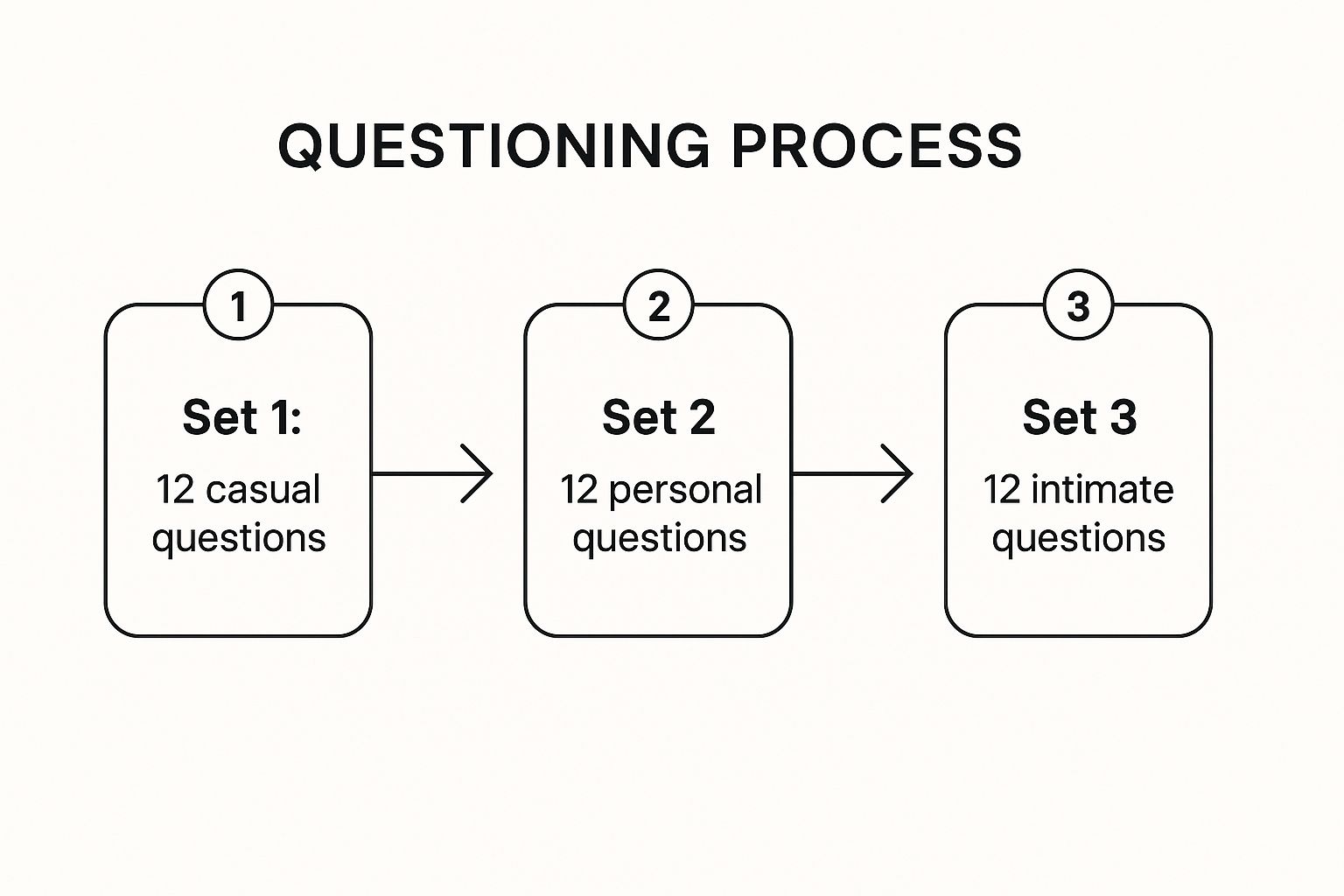Ignite Your Spark: Reconnect with Your Partner
Want to deepen your connection with your partner? This listicle provides seven intimacy exercises for couples to strengthen your bond and reignite passion. Learn practical techniques like eye gazing, the 36 questions that lead to love, sensate focus, and more. These intimacy exercises for couples improve communication, build trust, and foster a deeper understanding of your partner’s needs and desires, leading to a more fulfilling and intimate relationship. Ready to reconnect? Let’s get started.
1. Eye Gazing
Eye gazing, also known as soul gazing, is a powerful intimacy exercise for couples seeking a deeper connection. This deceptively simple practice involves partners sitting comfortably facing each other and maintaining sustained eye contact for a period of time, typically 3-5 minutes, without speaking. This non-verbal communication exercise bypasses the intellectual mind and taps into a deeper level of presence and vulnerability, fostering a sense of closeness and understanding that transcends words. It’s a remarkably effective way to build intimacy quickly and help partners feel truly seen, heard, and acknowledged, even without verbalizing their feelings.

This exercise deserves a top spot on any list of intimacy exercises for couples due to its accessibility and profound impact. It requires no special equipment and can be done virtually anywhere, making it a readily available tool for enhancing intimacy. The practice itself creates vulnerability and deepens trust, leading to stronger emotional bonds. This is particularly beneficial for men in relationships who may sometimes struggle with verbalizing their emotions, offering a powerful alternative for expressing love and connection. Furthermore, eye gazing triggers neurochemical bonding responses, further solidifying the sense of connection on a physiological level.
Examples of Successful Implementation:
Eye gazing has been utilized for centuries by Tantric practitioners as a method for deepening connection and intimacy. Relationship therapist John Gottman uses a variation of eye gazing in his “Love Lab” research, observing its impact on couple interaction and bonding. Artist Marina Abramović brought this practice into the public eye with her performance art piece “The Artist Is Present,” demonstrating its power to connect even strangers in a profound way.
Actionable Tips for Eye Gazing:
- Start Small: Begin with shorter durations (1-2 minutes) and gradually increase the time as you become more comfortable.
- Physical Proximity: Sit close enough that your knees can touch, fostering a sense of physical closeness and shared space.
- Use a Timer: Set a timer so you don’t have to break eye contact to check the clock, maintaining the flow of the exercise.
- Soft Gaze: Aim for a soft, relaxed gaze rather than an intense stare, which can feel confrontational.
- Post-Gazing Processing: After the eye gazing session, take time to discuss your experience with your partner. Share what you noticed, felt, and any emotions that arose. This verbal processing is crucial for integrating the experience and further deepening your connection.
When and Why to Use Eye Gazing:
Eye gazing can be incorporated into your relationship in various ways:
- Regular Practice: Schedule regular eye gazing sessions, perhaps weekly or monthly, to proactively nurture intimacy.
- During Conflict: When experiencing conflict, eye gazing can help to de-escalate tension and reconnect with your partner’s emotional state.
- Spontaneous Connection: Utilize eye gazing spontaneously when you feel a desire to deepen connection with your partner in a given moment.
Pros:
- Builds emotional intimacy quickly
- Helps partners feel truly seen and acknowledged
- Creates neurochemical bonding responses
- Can be practiced anywhere
- Effective even for couples who struggle with verbal expression
Cons:
- May feel uncomfortable or awkward initially
- Can bring up emotional responses that need processing
- Can be challenging for people with social anxiety or past trauma relating to eye contact. If this is the case, consider exploring alternative intimacy exercises.
This powerful intimacy exercise for couples can be transformative for your relationship, helping you and your partner develop a deeper level of understanding, connection, and love.
2. The 36 Questions That Lead to Love
Looking for intimacy exercises for couples? This exercise, based on the work of psychologist Arthur Aron, offers a structured approach to building closeness through vulnerability and self-disclosure. “The 36 Questions That Lead to Love” guides partners through three sets of increasingly personal questions, creating a pathway for deeper connection. The questions range from lighthearted icebreakers to profound inquiries about life, dreams, and vulnerabilities. This exercise fosters intimacy by encouraging couples to share their inner worlds with each other in a safe and structured environment. It’s designed to accelerate emotional intimacy and facilitate meaningful conversation, even in long-term relationships.

The infographic illustrates the process of the 36 questions exercise, starting with setting the stage in a comfortable environment, progressing through the three sets of questions with increasing intimacy, and culminating in the optional four-minute eye-gazing exercise. The increasing intensity of the questions is visually represented, highlighting the progression from superficial to deep sharing. The visualized process emphasizes the importance of taking time, creating a safe space, and allowing for authentic responses.
This method works by gradually increasing the level of vulnerability between partners. As you and your partner take turns asking and answering each question, you progressively reveal more personal information about yourselves. This reciprocal self-disclosure creates a sense of shared intimacy and understanding. The structured format provides a framework for meaningful conversation, making it easier to delve into topics you might not normally discuss.
The 36 Questions have gained considerable popularity, especially after being featured in Mandy Len Catron’s viral Modern Love essay in The New York Times titled “To Fall in Love With Anyone, Do This”. Catron documented her experience with the questions, recounting how they helped her and a stranger fall in love. Many relationship therapists have also adopted modified versions of these questions for use in couples counseling.
This exercise deserves its place on this list due to its evidence-based foundation and proven effectiveness in fostering intimacy. Its key features include the structured conversation format, the three sets of 12 questions with escalating intimacy, and the approximate 45-90 minute time commitment required. Its benefits include creating accelerated emotional intimacy through structured vulnerability, helping couples discover new things about each other, and reinvigorating communication in stagnant relationships. However, some couples may find the structured format contrived, and the time commitment might be challenging. Furthermore, some questions may trigger difficult emotions or memories, so proceeding with sensitivity is crucial.
Tips for using The 36 Questions:
- Create a comfortable and private environment: Minimize distractions to allow for focused conversation.
- Don’t rush: Allow ample time for reflection and meaningful responses. Consider breaking the exercise into multiple sessions if necessary.
- Listen actively and without judgment: Create a safe space for open and honest sharing.
- Optional: Conclude with the four-minute eye gazing exercise for an added layer of connection.
When and why to use this approach: This exercise is particularly beneficial for couples seeking to deepen their emotional intimacy, rekindle their connection, or improve communication. It can be a valuable tool for couples at any stage of their relationship, whether you are just starting out or have been together for years. Men, particularly those who may find it difficult to express emotions or communicate openly, can benefit greatly from the structured format and guided self-disclosure provided by this exercise. It provides a safe and supportive framework for exploring vulnerability and building deeper connection with their partner.
3. Sensate Focus Exercises
Sensate Focus exercises are a powerful tool for couples seeking deeper intimacy and connection. Developed by pioneering sex therapists Masters and Johnson, this series of structured touching exercises is designed to reduce performance anxiety and enhance sensual awareness. Instead of focusing on achieving orgasm, Sensate Focus encourages partners to explore touch purely for the sake of experiencing the sensations in the moment. This mindful approach allows couples to rediscover the pleasure of physical connection without the pressure of performance, making it a valuable intimacy exercise for couples.

Sensate Focus unfolds in progressive stages over multiple sessions. Initially, intercourse is prohibited, removing the pressure to “perform.” One partner touches the other, focusing on different textures, temperatures, and pressures. The receiving partner simply notices the sensations without feeling obligated to reciprocate or reach climax. As comfort and trust build, the exercises progress to include more intimate areas of the body. This structured approach helps establish clear boundaries and fosters open communication about preferences.
Why Sensate Focus Deserves Its Place on the List: Sensate Focus addresses a core challenge many couples face: anxiety around intimacy. By shifting the focus away from achieving orgasm, it allows partners to truly connect with each other on a physical and emotional level. This can be particularly beneficial for men who experience performance anxiety or feel pressured to prioritize their partner’s pleasure over their own. By exploring touch in a non-goal-oriented way, men can learn to appreciate the nuances of their partner’s body and understand her unique responses to different types of touch. This deepened understanding can be transformative for both partners, fostering greater intimacy and satisfaction.
Features and Benefits:
- Progressive Stages: The structured approach allows couples to gradually build comfort and trust.
- Removes Performance Pressure: By eliminating the goal of orgasm, partners can relax and focus on the sensory experience.
- Mindfulness and Presence: The emphasis on being present in the moment enhances sensual awareness.
- Improved Communication: Partners learn to express their preferences without criticism, fostering a more open and receptive dynamic.
Pros and Cons:
Pros:
- Effectively treats sexual dysfunction and anxiety around intimacy.
- Rebuilds physical connection in couples experiencing intimacy avoidance.
- Creates new pathways of pleasure beyond routine patterns.
- Can reignite physical desire in long-term relationships.
Cons:
- Requires a significant time commitment.
- Initial stages may feel mechanical or clinical.
- Can temporarily create frustration before a breakthrough is achieved.
- Requires vulnerability.
Examples of Successful Implementation:
- Standard protocol in sex therapy for treating various sexual dysfunctions, including erectile dysfunction and low libido.
- Used successfully in treating desire discrepancy between partners.
- Implemented in tantric workshops focused on conscious sexuality.
Actionable Tips:
- Create a warm, comfortable environment free of distractions.
- Use quality massage oil or lotion if desired.
- Establish clear time boundaries (15-30 minutes) for each partner’s turn.
- Communicate preferences using “I like” statements.
- Progress through the stages only when both partners feel comfortable.
- Consider working with a trained sex therapist for guidance.
When and Why to Use This Approach: Sensate Focus is particularly beneficial for couples experiencing challenges related to intimacy, desire discrepancy, sexual dysfunction, or performance anxiety. It’s a valuable tool for rebuilding connection, exploring new avenues of pleasure, and fostering greater understanding between partners.
Popularized by pioneering sex researchers Dr. William Masters and Virginia Johnson, and further brought into mainstream media by Dr. Ruth Westheimer, Sensate Focus remains a powerful technique for enhancing intimacy. Contemporary relationship therapists like Esther Perel continue to incorporate elements of Sensate Focus into their approach, recognizing its enduring value in helping couples connect on a deeper level.
4. Love Maps Exercise
Looking for effective intimacy exercises for couples? The Love Maps Exercise, developed by renowned relationship researcher Dr. John Gottman, is a powerful tool for building cognitive intimacy and strengthening your bond. This exercise helps couples delve deeper into each other’s inner worlds, creating detailed mental “maps” of their partner’s thoughts, feelings, and experiences. It’s about truly knowing your partner – their hopes, dreams, worries, stresses, and joys.

The exercise involves partners taking turns asking and answering open-ended questions about various aspects of each other’s lives. This question-based exploration can be facilitated by a card deck with prepared questions, such as The Gottman Institute’s Love Maps Card Deck, or you can create your own questions tailored to your relationship. Even seemingly small details, like knowing your partner’s favorite coffee order or their biggest current stressor at work, contribute to a deeper understanding and connection. This exercise deserves a spot on this list because it provides a structured yet adaptable way to foster intimacy on an intellectual and emotional level. The ongoing nature of the exercise helps couples stay connected as individuals grow and change over time.
Features and Benefits:
- Question-based exploration: Provides a structured way to explore your partner’s inner world.
- Card deck format: Offers pre-written questions for easy implementation.
- Short sessions: Can be practiced in 10-15 minute intervals.
- Research-based: Founded on Dr. Gottman’s extensive research with thousands of couples.
- Builds cognitive intimacy: Enhances knowledge and understanding of your partner.
- Creates a foundation for emotional support: Helps you better support your partner during life’s transitions.
- Tracks evolving identities: Ensures you stay updated on each other’s changing needs and desires.
- Reveals blind spots: Highlights areas where your understanding of your partner may be lacking.
- Easy integration: Can be seamlessly incorporated into regular routines.
Pros and Cons:
Pros: Builds cognitive intimacy, strengthens emotional support, keeps you updated on your partner’s evolving self, reveals blind spots, and is easy to incorporate into daily life.
Cons: Can feel like an interview if not approached with genuine curiosity, may uncover disconnections that require further discussion, and requires ongoing commitment for lasting impact.
When and Why to Use This Approach:
The Love Maps Exercise is valuable for couples at any stage of their relationship. It’s especially beneficial during times of transition (new job, moving, starting a family) or when feeling disconnected. Regularly engaging in this exercise can help men understand their partner’s emotional landscape, fostering a stronger connection and improving communication. By understanding your partner’s inner world, you’re better equipped to offer meaningful support and navigate challenges together. This understanding is crucial for men in relationships who want to deepen intimacy and build a lasting, fulfilling partnership.
Actionable Tips:
- Ask open-ended questions: Encourage deeper conversation and avoid simple yes/no answers. For example, instead of asking “Do you like your job?”, ask “What’s the most challenging and rewarding part of your job right now?”
- Practice active listening: Pay attention to your partner’s responses without judgment and show genuine interest.
- Schedule regular “Love Map” updates: Dedicate time weekly or monthly to connect using this exercise.
- Create your own questions: Personalize the exercise by including topics specific to your relationship.
- Consider using The Gottman Institute’s official Love Maps card deck: This provides a readily available resource with thought-provoking questions.
- Share your own answers even when not asked directly: This demonstrates vulnerability and encourages reciprocity.
Examples of Successful Implementation:
- Gottman Method Couples Therapy: A foundational exercise in this evidence-based therapy approach.
- Military Couples: Used to maintain connection and prepare for deployments.
- Premarital Counseling: Helps couples build a strong foundation before marriage.
For more resources and information, visit The Gottman Institute website (https://www.gottman.com/ ). By actively engaging in the Love Maps Exercise, you can create a deeper, more fulfilling connection with your partner, leading to increased intimacy and a stronger, more resilient relationship.
5. Synchronized Breathing: A Breath of Fresh Air for Your Relationship
Synchronized breathing is a powerful intimacy exercise for couples seeking a deeper connection, both physically and emotionally. This technique, which deserves its place on this list for its simplicity and profound impact, leverages the mind-body connection to foster a sense of shared presence and co-regulation. It’s a readily accessible practice that can enhance intimacy, reduce stress, and navigate conflict more effectively.
How it Works:
This intimacy exercise involves consciously matching your breathing rhythm with your partner’s. You sit facing each other, ideally making some form of physical contact like holding hands or a light embrace. Then, for 5-10 minutes (or longer as you become more comfortable), you focus on inhaling and exhaling together. This shared breath creates physiological synchrony, mirroring and amplifying the emotional connection between you.
Why Use Synchronized Breathing?
This exercise is particularly effective during periods of conflict or disconnection. By creating a shared physiological experience, synchronized breathing can de-escalate tension and foster a sense of calm. It activates the parasympathetic nervous system, reducing stress hormones and promoting a sense of safety and well-being. It’s also a fantastic entry point to mindfulness for couples who might be new to meditative practices. Beyond conflict resolution, it can be incorporated into your intimacy routine to enhance presence and connection during physical intimacy as well.
Examples of Successful Implementation:
The benefits of synchronized breathing are recognized across various therapeutic approaches and intimacy practices:
- Emotionally Focused Therapy (EFT): Stan Tatkin, a developer of the Psychobiological Approach to Couple Therapy, uses synchronized breathing as a pre-conflict intervention to foster emotional regulation and connection.
- Tantric Practices: Diana Richardson, a renowned tantric teacher and author, incorporates synchronized breathing into tantric intimacy practices to deepen connection and enhance energetic exchange.
- Mindful Sexuality Programs: Synchronized breathing is adapted in mindfulness-based sexuality programs to enhance presence and connection during physical intimacy.
Tips for Practicing Synchronized Breathing:
- Start Small: Begin with 2-3 minutes and gradually increase the duration as you become more comfortable.
- Get Comfortable: Sit facing each other with knees touching or in a comfortable embrace. You can also place one hand on your partner’s heart to feel their rhythm.
- Focus on Sensation: Focus on the sensation of breathing rather than trying to control it perfectly. Physical differences like lung capacity can make perfect synchronization challenging, so aim for a general rhythm rather than precise matching.
- Pre-Conflict Practice: Try practicing before difficult conversations to create emotional co-regulation and a more receptive environment for communication.
- Eye Contact (Optional): For an even deeper connection, experiment with maintaining eye contact during the exercise.
Pros:
- Activates the parasympathetic nervous system, reducing stress.
- Creates biological synchronization between partners.
- Accessible entry point to mindfulness for couples.
- Particularly effective during periods of conflict or disconnection.
- Requires no special equipment or extensive training.
Cons:
- May feel uncomfortable for those unused to meditation or close physical proximity.
- Physical differences (like lung capacity) can make perfect synchronization challenging.
- Requires the ability to focus and avoid distractions.
By incorporating synchronized breathing into your relationship, you can cultivate a deeper sense of intimacy, enhance communication, and navigate challenges with greater ease. This simple yet powerful practice offers a tangible way to strengthen your bond and experience a more profound connection with your partner.
6. Appreciation Exchange: Fueling Connection Through Gratitude
The Appreciation Exchange is a powerful intimacy exercise for couples seeking to strengthen their bond and cultivate a more positive dynamic. This structured gratitude practice offers a direct pathway to fostering emotional intimacy by encouraging partners to express specific appreciations for each other. It deserves its place on this list because, unlike grand gestures, it focuses on the small, everyday actions that often go unnoticed, yet contribute significantly to a relationship’s health. This exercise effectively uses positive reinforcement to boost connection and counteract the negativity bias that can creep into even the strongest relationships.
How it Works:
This exercise involves a simple yet profound exchange of positive feedback. Partners take turns expressing 3-5 detailed observations about qualities, actions, or characteristics they genuinely value in the other. The key is to be specific and focus on recent examples. Instead of saying, “You’re a good cook,” try, “I really appreciated you making my favorite lasagna last night after my long day at work. It meant a lot to me.” This level of detail makes the appreciation feel more genuine and impactful. The entire exchange can typically be completed within 10-15 minutes.
Why Use the Appreciation Exchange?
This exercise offers numerous benefits for couples looking to deepen their intimacy:
- Creates a Culture of Appreciation: Regular practice cultivates a positive atmosphere in the relationship, where both partners feel seen and acknowledged.
- Counteracts Negativity Bias: Relationships can sometimes fall into a pattern of focusing on the negative. This exercise helps shift the focus to the positive aspects of the partnership.
- Strengthens Feelings of Value: Hearing specific appreciations makes partners feel valued for their contributions to the relationship.
- Rewires the Brain: Consistently focusing on positive attributes trains the brain to notice and appreciate them more readily.
- Simple and Effective: This exercise is easy to implement and can provide immediate benefits.
Actionable Tips for Success:
- Be Specific and Detailed: Avoid generic compliments. “I love how patient you were with me when I was struggling to assemble the bookshelf yesterday” is far more impactful than “You’re so patient.”
- Mix it Up: Include a combination of character traits, behaviors, and the impact their actions have on you.
- Maintain Eye Contact: This shows your partner that you are present and engaged in the exchange.
- Receive Graciously: Simply accept the appreciations without deflecting or minimizing them. A simple “Thank you” is perfect.
- Journaling: Consider writing down appreciations in a shared journal to create a tangible record of your gratitude.
- Daily Practice: Try incorporating a daily practice of sharing three specific appreciations before bed.
Examples and Popularization:
The Appreciation Exchange is a cornerstone of Dr. John Gottman’s “culture of appreciation” approach, highlighting its significance in building successful relationships. It is also incorporated into positive psychology interventions for couples by experts like Martin Seligman. Even corporate settings have adapted the concept as “appreciation circles” for team building, demonstrating its broad applicability.
Pros and Cons:
While highly beneficial, the Appreciation Exchange requires genuine effort. If approached insincerely, it can feel forced or inauthentic. It may also be challenging during periods of significant relationship distress. It’s important to remember that this exercise is a tool for building intimacy, not a substitute for addressing underlying relationship problems.
By incorporating the Appreciation Exchange into your relationship, you can cultivate a stronger sense of connection, gratitude, and overall intimacy. This exercise, when practiced with sincerity and consistency, can be a powerful catalyst for positive change and a deeper understanding between partners. This exercise can be a particularly valuable tool for men in relationships who are looking for ways to deepen their connection with their partner and express their appreciation in a meaningful way.
7. Non-Sexual Physical Intimacy Ritual
This intimacy exercise focuses on fostering physical closeness without the pressure of sexual activity. It’s a powerful way for couples to rebuild trust, enhance physical comfort, and expand their understanding of intimacy beyond the bedroom. The Non-Sexual Physical Intimacy Ritual involves setting aside dedicated time, typically 15-30 minutes, for focused, non-sexual touch. This might include gentle caressing, massage, or simply holding each other. The key is the explicit agreement that this time will not lead to sex, creating a safe space for vulnerability and connection.
This approach is particularly beneficial for couples experiencing a desire discrepancy, where one partner has a higher sex drive than the other. By separating affection from sexual expectations, it reduces anxiety around touch and helps the lower-desire partner feel less pressured. It can also be incredibly helpful for couples recovering from infidelity or navigating the challenges of parenthood, where touch can sometimes become associated with stress or obligation rather than pleasure. In these situations, the Non-Sexual Physical Intimacy Ritual helps rebuild physical trust and rediscover the joy of simple physical connection. It breaks cycles of touch avoidance and creates a foundation for a more fulfilling and intimate relationship.
How it Works:
The ritual is based on the principle of mindful touch, emphasizing the giving and receiving of affection with intention and presence. Partners take turns being the giver and receiver, ensuring an equal exchange of nurturing touch. Creating a comfortable environment is crucial – think appropriate temperature, privacy, perhaps some calming music or dim lighting. Massage oil can also enhance the sensory experience.
Examples of Successful Implementation:
This technique is often used in therapy for sexual desire discrepancies, as part of recovery plans for couples healing from infidelity, and as a reconnection tool for parents after having children. Its effectiveness lies in its ability to re-establish a safe and positive association with physical touch.
Tips for Success:
- Establish clear agreements: Before beginning, discuss boundaries and ensure both partners are comfortable with the parameters of the exercise.
- Create a comfortable environment: Set the stage for relaxation with appropriate temperature, privacy, and perhaps soothing music or dim lighting.
- Equal time: Take turns being the giver and receiver of touch in equal timeframes.
- Communicate preferences: Express your needs clearly. For instance, “I would enjoy more pressure,” or “I would prefer gentler touch.”
- Use a timer: A timer can help maintain the agreed-upon time boundaries, especially in the beginning.
- Practice regularly: Aim for 1-2 times weekly for maximum benefit. Start with shorter sessions (10 minutes) and gradually increase the duration as you become more comfortable.
Pros:
- Helps rebuild physical trust, especially in couples with desire discrepancies.
- Reduces anxiety around touch for partners who feel pressured.
- Creates a safe space for physical connection without performance expectations.
- Expands the repertoire of physical intimacy beyond sexual contact.
- Can help break cycles of touch avoidance.
Cons:
- May initially increase frustration for higher-desire partners.
- Requires clear communication and respect for boundaries.
- Can feel artificial until established as a regular practice.
Building resilience as individuals is crucial, but couples can also cultivate shared resilience through practices like open communication, creating shared goals, and working together to overcome challenges. For more ways to strengthen resilience, both individually and as a couple, explore these helpful exercises: Resilienz stärken Resilience, like intimacy, is built through consistent effort and mindful attention.
This Non-Sexual Physical Intimacy Ritual deserves its place on this list of intimacy exercises for couples because it addresses a fundamental aspect of connection that is often overlooked. It provides a pathway to rediscover the simple pleasure and comfort of touch, strengthening the bond between partners in a profound and meaningful way. Pioneered by experts like Dr. Barry McCarthy, Dr. Linda Weiner, and Dr. Lori Brotto, this exercise offers a practical and effective way to nurture intimacy and deepen connection.
Intimacy Exercises Comparison Guide
| Exercise | Implementation Complexity  |
Resource Requirements  |
Expected Outcomes  |
Ideal Use Cases  |
Key Advantages  |
|---|---|---|---|---|---|
| Eye Gazing | Low – Simple, brief (3-10 min), no equipment | None | Deep emotional intimacy; vulnerability; trust | Quick emotional connection; couples with verbal barriers | Builds neurochemical bonding; portable and easy |
| The 36 Questions That Lead to Love | Medium – Structured, time-intensive (45-90 min) | Comfortable, private setting | Accelerated emotional intimacy via self-disclosure | Couples seeking deep conversation; reinvigorate communication | Research-based; clear guided process |
| Sensate Focus Exercises | High – Multi-session, staged touch exercises | Private space, optional massage oils | Reduced sexual anxiety; enhanced sensual awareness | Couples with sexual dysfunction or intimacy avoidance | Treats sexual dysfunction; enhances physical connection |
| Love Maps Exercise | Low to Medium – Short sessions (10-15 min) | Question cards or prepared prompts | Increased cognitive intimacy; updated partner knowledge | Couples wanting to deepen understanding; regular check-ins | Easy to incorporate regularly; builds emotional support |
| Synchronized Breathing | Low – Brief sessions (5-15 min) | None | Physiological and emotional attunement; stress reduction | Conflict resolution; mindfulness beginners | Activates parasympathetic system; accessible practice |
| Appreciation Exchange | Low – Short, structured (10-15 min) | None | Increased gratitude; positive reinforcement | Daily or weekly relationship maintenance | Counteracts negativity bias; immediate positive effect |
| Non-Sexual Physical Intimacy Ritual | Medium – 15-30 min sessions with boundary setting | Comfortable private space, optional oils/music | Rebuilt physical trust; reduced touch anxiety | Desire discrepancy; rebuilding after trauma or infidelity | Creates safe, pressure-free physical connection |
Nurturing Lasting Connection: Your Journey to Intimacy Starts Now
From the simple power of eye gazing to the in-depth exploration of love maps, these seven intimacy exercises for couples offer a diverse toolkit for strengthening your bond. We’ve covered techniques to reignite passion through sensate focus exercises, foster understanding with the 36 questions, and deepen your connection through synchronized breathing and appreciation exchanges. Remember, even incorporating non-sexual physical intimacy rituals can significantly impact your relationship’s overall intimacy. The most important takeaway is that consistent effort, vulnerability, and open communication are crucial for success with these intimacy exercises for couples. Mastering these approaches will not only enhance your romantic life but also contribute to a greater sense of fulfillment and connection in your relationship. Building true intimacy takes time and dedication, but the rewards – a stronger, more fulfilling partnership – are immeasurable.
Want to further enhance your understanding of your partner’s body and desires, leading to even deeper intimacy? G-Spot 101 provides detailed information and resources designed to help you explore and understand female anatomy and pleasure, empowering you to create even more intimate and satisfying experiences together. Visit G-Spot 101 today to begin your journey towards a more fulfilling and intimate connection.
The post Top Intimacy Exercises for Couples to Deepen Your Bond appeared first on G Spot 101 .
Intimate Tickles found this article quite interested, and we thought you might to. We give all the credit for this article to gspot. Click Here To Read This Article From It's Original Source



